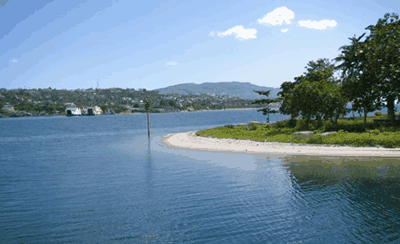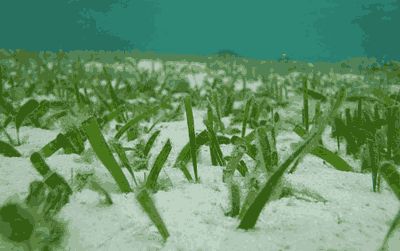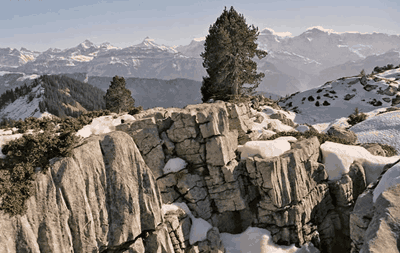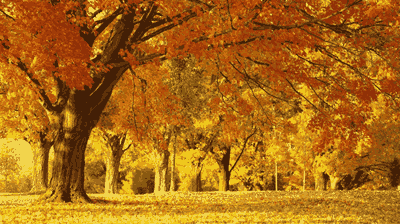ECOSYSTEM: Definition, Components, Types, Examples
Ecosystem is an ecological system formed by the inseparable reciprocal relationship between living things and their environment.
Abiotic or non-living components are physical and chemical components which are the medium or substrate in which life takes place, or the environment in which life occurs. It can be organic and inorganic compounds.
C. Ecosystem Types
In general, there are three types of ecosystems, namely aquatic ecosystems, terrestrial ecosystems, and artificial ecosystems.
C.1 AQUATIC (WATER)
1. Marine ecosystem
Characterized by high salt content with CI- ions reaching 55%, especially in tropical ocean areas, because the temperature is high and evaporation is large.
2. Estuary Ecosystem
Estuary (estuary) is a place where the river and the sea unite. Estuaries are often fenced off by extensive intertidal mud slabs or salt marshes. Estuary ecosystems have high productivity and are rich in nutrients.
Examples of plants: salt marsh grass, algae, and phytoplankton.
Examples of animals: worms, shellfish, crabs, and fish.
3. Freshwater Ecosystem
The characteristics of freshwater ecosystems include subtle temperature variations, less light penetration, and are affected by climate and weather. Examples of many types of algae.
4. River ecosystem
The river water is cold and clear and contains little sediment and food. The water temperature varies with altitude and latitude.
Examples of river ecosystems are inhabited by animals such as carp, turtles, snakes, crocodiles.
5. Deep sea ecosystem
Its depth is more than 6,000 m. Generally found sea catfish and marine fish that can emit light. There are bacteria in symbiosis with certain corals as producers.
6. Seagrass Ecosystem

Seagrass is the only group of flowering plants that live in the marine environment.
Precisely in shallow coastal waters.
Like grasses on land they have erect leafy shoots and creeping stalks that are effective for breeding.
7. Coastal ecosystem
It is so named because the one that grows the most in the sand dune is the plant Ipomoea pes caprae which resistant to waves and wind.[5] Plants that live in this ecosystem spread and have leaves thick.[5]
8. Coral reef ecosystem
Consisting of coral that is near the coast, the efficiency of the coral reef ecosystem is very high. The presence of coral reefs near the beach makes the beach has white sand.
Living things that live among corals and algae such as various invertebrates, fish, micro-organisms.
Herbivores such as snails, sea urchins, fish, become prey for octopuses, starfish, and carnivorous fish.
C.2 TERRESTERIAL (LAND)
Terrestrial ecosystem areas are determined by rainfall and temperature. These ecosystems are controlled through disturbances and climate. Ecosystem patterns can change due to fire, lightning, and humans.
1. Meadow
It extends from the topic area to the subtropics. Has a rainfall of approximately 25-30 cm per year, rain falls irregularly, fast water flow, and high water infiltration.
Examples of plants: wolves, elephants, giraffes, insects, kangaroos, mice, grass, zebras, bison.
2. Desert
It is in the tropics bordering the grasslands. It has low rainfall (25 cm per year and is arid.
An example of a typical plant: cactus.
Examples of living animals: lizards, scorpions, frogs, ants.
3. Karst (limestone / cave)

In Indonesia, the karst area has almost the same characteristics, namely the soil is less fertile for agriculture, prone to erosion, and prone to landslides.
This ecosystem has its own uniqueness, with a variety of biotic aspects that are not found in other ecosystems.
4. savanna
Located in the tropics with rainfall of 40-60 inches per year, but temperature and humidity depending on the season.
The largest savanna is in Africa. Animals that live in the savanna such as: zebras, lions and hyenas
5. Tundra
It is in the northern hemisphere in the arctic circle and is found on the tops of high mountains. The growth of the plant is only 60 days.
Examples of plants: sphagnum, annual seed plants, lichen, herbaceous plants, and reed grass.
6. deciduous forest

It is in an area with a 4 season climate with evenly distributed rainfall throughout the year. The tree species are few and not too dense.
Animals that live in deciduous forests: foxes, woodpeckers, raccoons, squirrels, bears.
7. Tropical rain forest
Located in the tropics and subrtopics, has the characteristics of rainfall between 200-225 cm per year. Many tree species with different types according to their geographical location.
In wet forests there is a change in the microclimate, namely the climate that is directly around the organism.
The hood area gets enough sunlight, variations in temperature and humidity are high, the temperature throughout the day is around 25 °C.
Examples of typical plants in tropical rain forests: lianas (rattan) and orchids as epiphytes.
Examples of animals: monkeys, rhinos, birds, tigers, wild boars and owls.
8. Taiga
Found in the northern hemisphere and in the mountains of the tropics, characterized by low temperatures in winter. Generally, taiga is a forest formed from one species such as pine, conifer, and the like.
Wet plants and very few shrubs. Black bears and birds migrate south in autumn.
C.3 MADE
This ecosystem is created by humans to meet needs. This ecosystem gets energy from outside and has low diversity.

Examples of artificial ecosystems are:
- production forest plantations such as teak and pine
- dam
- agroecosystems in the form of rainfed rice fields
- Palm plantations
- irrigated rice field
- space ecosystem
- residential ecosystems such as cities and villages.
Yuksinau.id add a little about the causes of damaged ecosystems, because ecosystems can be damaged at any time, the causes of ecosystem damage can be natural and due to human factors.
Natural factors such as floods, tsunamis, landslides, volcanic eruptions, and others. While human factors such as excessive tree cutting, forest burning, fishing with poison and bombs, industrial waste and others.
YukSinau.id is the #1 educational site that you can use as a learning reference
